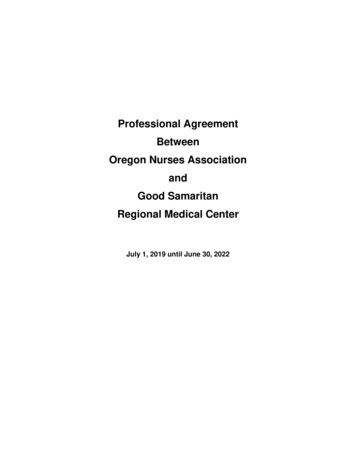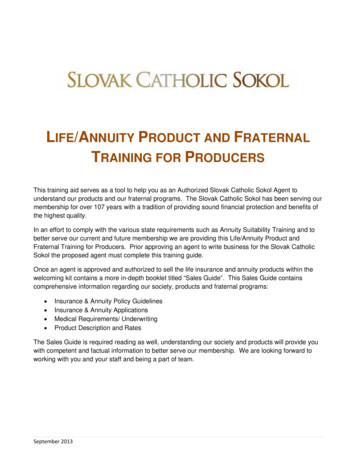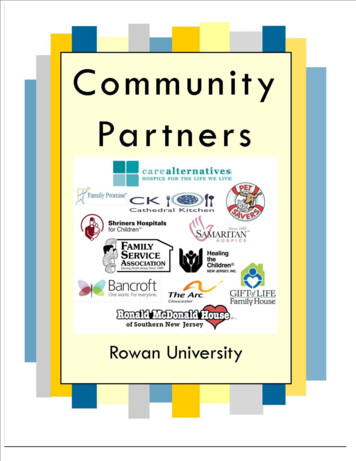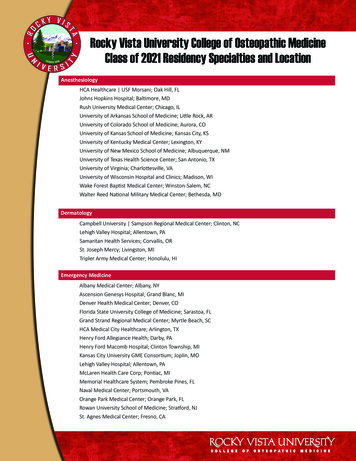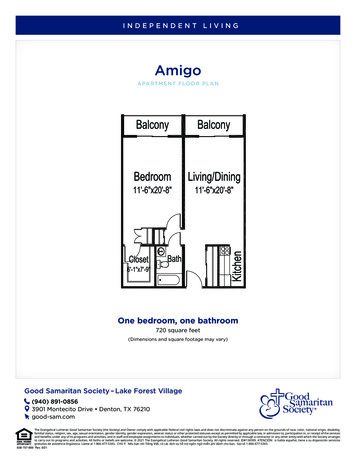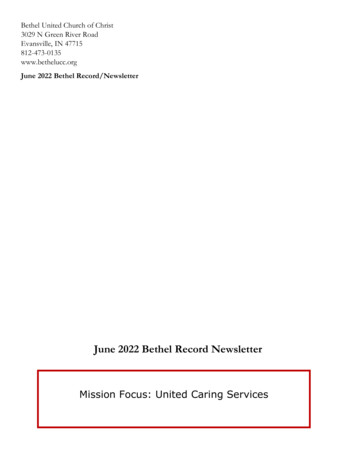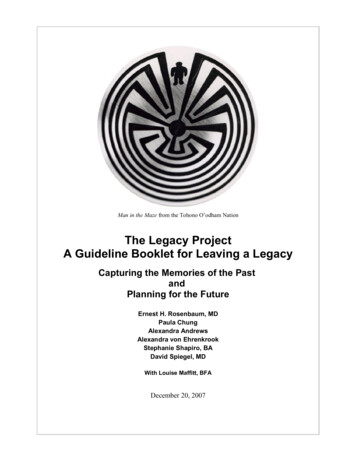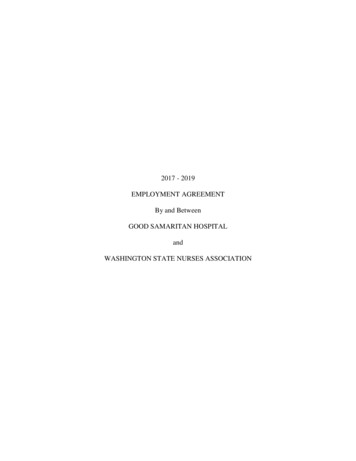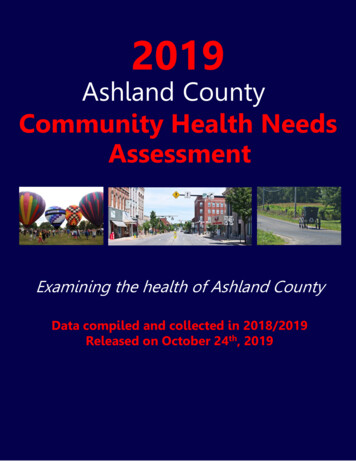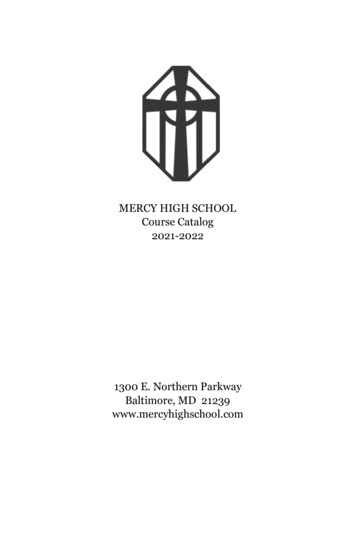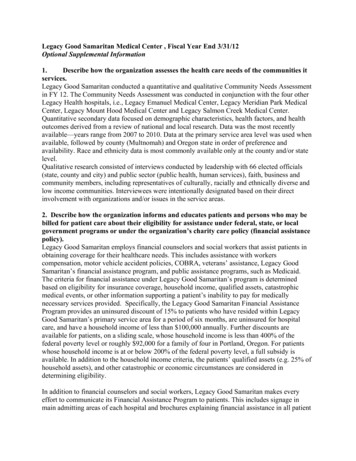
Transcription
Legacy Good Samaritan Medical Center , Fiscal Year End 3/31/12Optional Supplemental Information1.Describe how the organization assesses the health care needs of the communities itservices.Legacy Good Samaritan conducted a quantitative and qualitative Community Needs Assessmentin FY 12. The Community Needs Assessment was conducted in conjunction with the four otherLegacy Health hospitals, i.e., Legacy Emanuel Medical Center, Legacy Meridian Park MedicalCenter, Legacy Mount Hood Medical Center and Legacy Salmon Creek Medical Center.Quantitative secondary data focused on demographic characteristics, health factors, and healthoutcomes derived from a review of national and local research. Data was the most recentlyavailable—years range from 2007 to 2010. Data at the primary service area level was used whenavailable, followed by county (Multnomah) and Oregon state in order of preference andavailability. Race and ethnicity data is most commonly available only at the county and/or statelevel.Qualitative research consisted of interviews conducted by leadership with 66 elected officials(state, county and city) and public sector (public health, human services), faith, business andcommunity members, including representatives of culturally, racially and ethnically diverse andlow income communities. Interviewees were intentionally designated based on their directinvolvement with organizations and/or issues in the service areas.2. Describe how the organization informs and educates patients and persons who may bebilled for patient care about their eligibility for assistance under federal, state, or localgovernment programs or under the organization’s charity care policy (financial assistancepolicy).Legacy Good Samaritan employs financial counselors and social workers that assist patients inobtaining coverage for their healthcare needs. This includes assistance with workerscompensation, motor vehicle accident policies, COBRA, veterans’ assistance, Legacy GoodSamaritan’s financial assistance program, and public assistance programs, such as Medicaid.The criteria for financial assistance under Legacy Good Samaritan’s program is determinedbased on eligibility for insurance coverage, household income, qualified assets, catastrophicmedical events, or other information supporting a patient’s inability to pay for medicallynecessary services provided. Specifically, the Legacy Good Samaritan Financial AssistanceProgram provides an uninsured discount of 15% to patients who have resided within LegacyGood Samaritan’s primary service area for a period of six months, are uninsured for hospitalcare, and have a household income of less than 100,000 annually. Further discounts areavailable for patients, on a sliding scale, whose household income is less than 400% of thefederal poverty level or roughly 92,000 for a family of four in Portland, Oregon. For patientswhose household income is at or below 200% of the federal poverty level, a full subsidy isavailable. In addition to the household income criteria, the patients’ qualified assets (e.g. 25% ofhousehold assets), and other catastrophic or economic circumstances are considered indetermining eligibility.In addition to financial counselors and social workers, Legacy Good Samaritan makes everyeffort to communicate its Financial Assistance Program to patients. This includes signage inmain admitting areas of each hospital and brochures explaining financial assistance in all patient
care areas, as well as in appropriate languages. Financial counselors are available to assistpatients in understanding and applying for available resources, including the Legacy GoodSamaritan Financial Assistance Program. Legacy Good Samaritan's website also hasinformation about the availability of financial assistance. Legacy Good Samaritan offersfinancial assistance customer service Monday through Friday, as well as the availability of voicemail so patients can leave confidential, detailed messages during non-business hours. Finally allof Legacy’s billing statements include information regarding the availability of financialassistance. If Legacy Good Samaritan requires the use of a collection agency, those agencies arerequired to provide a telephone number that patients can call to request financial assistance.Annual education is provided to all billing and admitting staff so they can be kept informed ofand speak with knowledge about current financial assistance policies and options. Legacy GoodSamaritan provides copies of the latest policies in main admitting areas, as well as throughnewsletters and other publications.Since 2008, the four county metro area health delivery systems (encompassing all hospitals inthe area) and safety net clinics have partnered to establish a seamless, coordinated program toprovide care for the low income uninsured, Project Access. This program enables low incomeuninsured patients to receive continuity of care in earlier stages of acuity due to the collaborationamong 2800 providers and all health systems.3.Describe the community the organization serves, taking into account the geographicarea and the demographic constituents its serves.Legacy Good Samaritan is located in one of the original neighborhood establishing Portland-inner Northwest Portland bordering on downtown. The five mile primary service area extendsfrom the Columbia River in the north to south of Highway 99E in the south and from WalkerRoad in the west to NE/SE 82nd in the east. The service area includes the close in neighborhoodcommunities of Nob Hill, Old Town/Chinatown, Pearl District, John’s Landing, Lair Hill, WestSylvan, Garden Home, Multnomah Village, Forest Heights, West Slope, Cedar Mills and others.Some of these neighborhoods include both the wealthiest in the metro area and the verypoorest—within blocks of each other. As a tertiary facility, Legacy Good Samaritan drawspatients from the five mile primary service area and throughout Multnomah County and evenfrom the other metro area counties. Thus, Multnomah County data is very appropriate to LegacyGood Samaritan’s draw.In November 2010, the Portland State University (PSU) Population Research Center reported theOregon metro area tri-county population at 1,644,535 residents; with Clark County, the fourcounty area was 2,080,926.The primary service area included 443,503 people in 2010; projected .5 percent annual growthbetween 2010 and 2015 is the lowest of Legacy Health hospital service areas. County rankings inthe metro are shifting. In 1960, 59 percent of the population lived in Multnomah County; by2008, it was only 33 percent.Median age was 37.8 years in Oregon in 2009. Multnomah County was 36.9 years.
By ethnicity, in 2010 the Legacy Good Samaritan primary service area was 74.1 percent nonHispanic white, 8.6 percent Hispanic, 6.6 percent African American, 5.9 percent Asian, 3.4percent bi-racial and 0.7 percent Native American. While communities of color are less visibleon the inner west of the Willamette River in Legacy Good Samaritan’s surroundingneighborhoods, this area is the site of a significant portion of the homeless and here communitiesof color are disproportionately represented, i.e., often over 25 percent of the population.Legacy Good Samaritan’s charity care costs totaled 14.1 million in FY 12. Total unreimbursedcosts were 39.3 million.4. Describe how the organization’s community building activities promote the health of thecommunities the organization serves.As a tertiary-care center, Legacy Good Samaritan provides several unique services to the regionsuch as neuroscience services, which includes the Rehabilitation Institute of Oregon, a regionalsleep disorders program, comprehensive epilepsy, stroke and brain tumor programs, Devers EyeInstitute, kidney transplant services, weight management institute, and a robotic surgical systemused for minimally invasive surgeries. In addition, Legacy Good Samaritan provides training forinterns and residents through its nationally accredited graduate medical education program, andpartners with schools to provide training and education for nursing and other healthprofessionals.The Legacy Good Samaritan five mile primary service area includes four other large tertiaryhospitals, including two trauma 1 centers. Legacy Good Samaritan Medical Center is one ofthese tertiary trauma 1 centers and located just two miles east of Legacy Good Samaritan.Providence Health and Services operates one of the other tertiary centers three miles west ofLegacy Good Samaritan and the other five miles east. The last tertiary and trauma 1 center isOHSU, which is also site of the only medical school in Oregon.With the long-standing income disparities in the Legacy Good Samaritan area, safety net serviceshave expanded. Multnomah County Health Department operates FQHCs in downtown Portlandand inner Northeast. The nonprofit safety net clinics are among the oldest and most credible inPortland. Central City Concern offers comprehensive medical (FQHC), housing, detox sobering,alcohol and drug rehabilitation and employment services for the homeless just one mile from thehospital. Legacy Good Samaritan contracts with Central City Concern to provide recuperativecare services for discharged patients in need of housing and other services. Wallace MedicalConcern is over 25 years old and also operates a clinic in Old Town Portland; Legacy GoodSamaritan provides inkind lab services, a financial donation, board representation andadministrative office space on its campus at no charge. Outside In is also an FQHC focusing onthe young adult homeless community, a large proportion of whom are LGBTQ.A local nonprofit, Project Access NOW, links uninsured low income individuals to providers andhealth system services providing services at no charge. All of the health systems in the metroarea are very involved with this program. Legacy Health, in addition to providing clinicalservices, provides cash donations and office space to the administrative offices of Project AccessNOW, inkind, on the Legacy Good Samaritan campus. Legacy Good Samaritan’s internal
medicine residency program operates a teaching clinic on-site serving the low income anduninsured.Legacy Good Samaritan has recognized that nonprofit organizations spend valuable dollars onoffice space and infrastructure — dollars better spent on meeting their missions. As a result,Legacy Good Samaritan has provided free office space and other infrastructure services tononprofit organizations on its campus. Additionally, Legacy Good Samaritan provides meetingspace to a variety of not for profit organizations free of charge to further their respectivemissions within the community.5. If the organization is part of an affiliated health system, describe the respective roles ofthe organization and its affiliates in promoting the health of the communities served as wellas any community benefit provided on behalf of the hospital.Legacy Good Samaritan is a subsidiary of Legacy Health (Legacy). Legacy is an integratedhealth system based in Portland, Oregon and primarily operates five acute care hospitals, achildren’s hospital and related services (e.g. physician practices, hospice, preferred providernetwork) in the greater Portland, Oregon and southwest Washington area.The Legacy Health Board is comprised of community and business leaders as well asrepresentatives of the medical staff. The Legacy Good Samaritan medical staff is open, withphysicians submitting credentialing information reviewed according to Legacy Good Samaritanpolicies and standards.While there is investment in a variety of community-based activities and programs as a part of itsnon-profit status, an overwhelming majority of Legacy and Legacy Good Samaritan’scommunity benefit comes in the form of providing uncompensated care. Legacy’s policy ofproviding care regardless of the ability to pay makes it one of the region’s largest providers ofuncompensated care in the four-county metropolitan area.In 1999, the Legacy Board allocated 10 million to establish a Community Health Fund fromoperating revenue to address major community health issues. For more than a decade, about 500,000 has been granted annually to community-based projects addressing racial and ethnicinequities and root causes. These dollars are in addition to Legacy’s other charitablecontributions. The Community Health Fund has provided grants since 1999 totaling 6.4million. 56% of the grants have addressed racial and ethnic disparities.Recognizing that education, employment and income inequities exist for communities ofdiversity, and that health professions are lacking in diversity, Legacy established the YouthEmployment in Summer program. African American, Native American and Hispanic youthreceive paid summer employment in departments where they worked with health professionalsand earned college scholarships between 2,500 and 5,000 annually. Students can remain inthe program as long as they stay in school and pursued healthcare careers. Some students haveremained in this program for as long as seven years and graduated with degrees in a variety ofhealthcare fields.
In 2010, Legacy Health established the CLEAR/Health Literacy initiative. Communication withpatients such that patients both understand AND can act on the information required of andprovided to them is critical to their health outcomes. Patients must use information to navigatethe health system (complete insurance and government forms, sign consents, scheduleappointments), manage diseases and acquire preventive screenings. Providers (defined as all staffinteracting with or developing materials used by patients) are responsible for ensuring thatpatients can act on the information provided. In 2012 and funded by the Community HealthFund, Legacy Health hosted the first Oregon and SW Washington Health Literacy Conference—360 people from 69 organizations attended. Legacy Health is now the recognized leader inmoving health literacy forward both in the health delivery system and broader community.In addition to the Community Health Fund, Legacy provided cash donations to local health andhuman service, education, economic development and civic organizations. Donations focus onorganizations with year-round relationships through programs and board representation. A fewexamples include The Wallace Medical Concern, Friendly House, Loaves and Fishes and DonateLife Northwest.Legacy encourages and supports employee volunteerism. Legacy donates 100 to nonprofithealth, human service or education organizations in honor of employees who volunteer onpersonal time 50 hours a year. Employees may receive paid time when volunteering in one ortwo week time periods in local nonprofit organizations through Legacy’s community serviceleave program.Non-cash donations of resources include clinical and non-clinical services and items, e.g.,screenings and support services, internships, information and referral services and health fairs.Legacy’s warehouse is open to nonprofit organizations to obtain surplus equipment andfurniture. In addition, conference room space is made available to local nonprofits for Board andcommunity meetings.A sister hospital, Legacy Good Samaritan, collaborates with other healthcare providers,community-based organizations, business and the public on projects to improve the health of thecommunity. Examples of clinically based partnerships include, among others: CARES NW(Child Abuse Response and Evaluation Services) is a collaboration among three health systems.Clinical staff is involved with local communities through many child safety programs. In 1986,nurses in Good Samaritan Hospital’s Level I Trauma Center developed the Trauma Nurses TalkTough (TNTT) program. Taught by trauma and emergency medical professionals, the programreaches 36,000 people each year. In addition, Legacy staff members conduct free checks to showparents how to properly install car seats. Last year, Legacy staff fit and sold more than 9,000bicycle helmets to children at a nominal or no fee based on need. Legacy staff members alsoprovide new parents with training to reduce the incidences of shaken baby syndrome and aSafety Store sells child protection devices for the home at nominal charge.The following summarizes the community benefit provided at other Legacy affiliated entities,other than Legacy Good Samaritan:
All Other Legacy AffiliatesPatientencountersCharity care at costTotal communitybenefit expenseDirect offsettingrevenueNet communitybenefit expense53,387,725053,387,725Unreimbursed costs of public dicare228,606,246122,787,771105,818,475Other public programsCommunity health 4,464Health professions educationn/a11,493,1622,965,2508,527,912Subsidized health servicesn/a000Cash and in-kind contributions to othercommunity 00650,053,953412,069,036237,984,917Community building activitiesCommunity benefit operationsTotals
these tertiary trauma 1 centers and located just two miles east of Legacy Good Samaritan. Providence Health and Services operates one of the other tertiary centers three miles west of Legacy Good Samaritan and the other five miles east. The last tertiary and trauma 1 center is OHSU, which is also site of the only medical school in Oregon.
